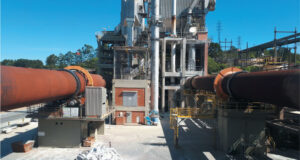techlink| DRYING
Blower Technology Proves Its Worth
Vacuum systems play a central role in the paper production process, but new technologies are giving papermakers more choices regarding the type of system to use. Paper manufacturers can realize numerous benefits from blower technology compared to traditional vacuum generation using water ring air pumps, according to MAN Diesel & Turbo, maker of the TURBAIR vacuum system developed and constructed at MAN Diesel & Turbo’s plant in Zurich, Switzerland.
Rising energy prices and growing environmental awareness are behind an increase in sales of vacuum blower systems to replace vacuum pumps, according to Manfred Dobler, head of paper industry at MAN Diesel & Turbo. “This is why the TUR-BAIR vacuum system is used for many new installations of paperboard, tissue and paper machines. At the same time, there is a strong trend toward conversion. In the past three months alone, we have received orders for well over 40 blowers, which proves the strong demand.”
Vacuum systems are deployed at the point in the production process at which the installation dewaters the paper. To do this, TURBAIR systems handle volume flow rates of 300 up to 3000 m³/min and vacuum levels up to 75 kPa.
“The technology gives paper, paperboard and tissue manufacturers a competitive advantage compared with conventional vacuum systems. Our vacuum system not only makes a significant contribution to environmental protection, it also enables a reduction of 40-50 percent in production costs on paper dewatering,” states Dobler.
RESOURCE-EFFICIENT AND COST-SAVING DEWATERING
The success of vacuum blower systems is based on a number of factors, Dobler says, including the following:
• Constructed using radial flow impellers, vacuum blowers generally have an absorbed energy consumption that is up to 30 percent lower than conventional water ring pumps since there is no frictional loss caused by the water ring.
• Vacuum blowers do not require seal water, so operators can save on fresh water.
• Depending on the grammage, speed, and material composition of the type of paper to be produced, the paper machine needs different volumes of air and vacuum levels for optimum, cost-effective dewatering. The TURBAIR blower types have a wide working range, so the blowers can also be efficiently operated under partial load. This leads to a further reduction in energy consumption of up to 30 percent.
• Another advantage is that the blowers have no wearing parts and are especially easy to service. Even older generation vacuum blowers installed by MAN more than 60 years ago are still in operation.
• As well as the broad working range of the blower, frequency-controlled drives are increasingly being used. This allows not only the air volume, but also the vacuums to be adapted to the conditions of the paper machine. This leads to as much as 20 percent further reduction in energy requirements.
“In combination, these benefits result in a simple return-on-investment calculation for our customers: the amortization time of a TURBAIR system of this kind installed in an existing paper production mill is not even two years,” says Dobler. Numerous conversion references evidence an energy savings of 45-65 percent of the absorbed power. This does not take into consideration the additional savings from the use of a one- to three-stage heat exchanger.
New tissue installations of TURBAIR systems include the following:
• SCA in Germany
• WEPA in Germany, France, and Poland
• FRIPA in Germany
• HAYAT in Turkey, Russia, and Egypt
• Ipek Kagit in Turkey
• Metsä Tissue in Poland
• First Quality Tissue in the US
• Sofidel in Poland and the US
TREND TOWARD VACUUM SYSTEM RETROFITS
Paper manufacturers are increasingly retrofitting their production plants with one-stage RT blowers; the old vacuum systems previously installed in existing tissue machines are being replaced with the TURBAIR technology. Model RT 56 is most popular for the narrow 2.8 m tissue machines with production speeds of up to 2200 m/min, while the larger RT 71 is the preferred model for 5.6 m tissue machines.
This technology covers all the usual manufacturing processes: conventional crescent former, TAD (through-air drying), ATMOS (Advanced Tissue Molding System) and Advantage NTT technology for producing sanitary paper.Figure 1 shows a few examples of how mills are using TURBAIR technology to replace the existing vacuum system.
Which Blower Type Should a Mill Use?
ONE-STAGE RT BLOWER WITH EMISSION REGULATION:
Depending on the size, an RT vacuum blower of 200 to 2200 m3/min and up to 60 kPA can be used. Thanks to the automatic outlet regulation, the volume flow adapts flexibly to the relevant requirements of the paper machines. The controller automatically governs the volume requirement from 30 to 100 percent. At the same time, the RT with a fre-quency-controlled drive can set the vacuum between 35 and 60 kPa.
This large area of application makes the RT range perfect for felt conditioning, tissue applications and, most importantly, replacing existing vacuum systems.
MULTI-STAGE RC BLOWER:
Depending on the size, the RC type vacuum blower can be used from 180 to 2800 m3/min and up to 75 kPa. With its up to four intake manifolds, all vacuum levels can be operated on the filter and press section. At the same time, the blower with a frequency-controlled drive can set the vacuum between 55 and 75 kPa. It is chiefly in demand for new installations for graphic papers, cardboard, or chemical pulp. These require a high vacuum, which the RC type blower supplies reliably, thanks to its multi-stage centrifugal design. It can replace entire water ringpump systems.
 Paper 360
Paper 360

